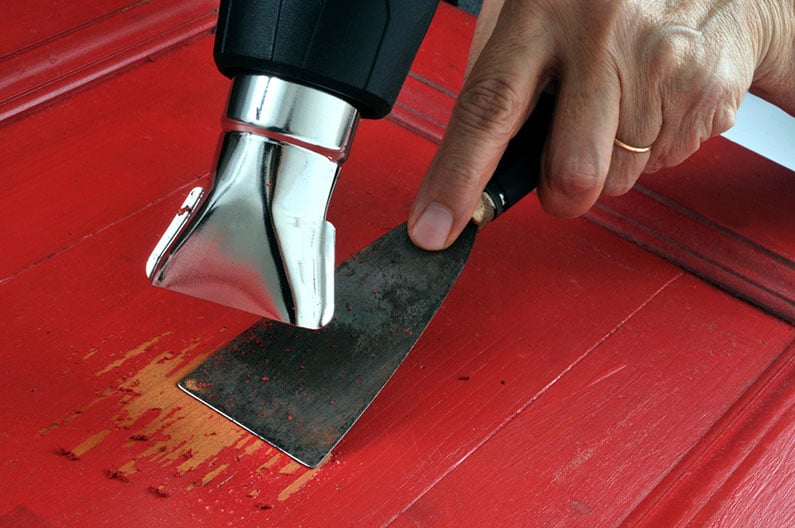
Safer than chemicals, and faster than sanding — a hot air machine removes the tedium, and can actually be fun to use.
However, there are a few safety measures and hacks that are crucial, to ensure you achieve awesome results.
Here’s everything you need to know about stripping paint with a heat gun.
Why Use Heat Gun to Remove Paint?
As the saying goes, there’s more than one way to skin a cat. And the same applies to removing paint.
For an in-depth comparison of the different methods (of stripping paint, not skinning cats), check out my article on how to remove paint from wood. However, in brief, here’s how they measure up:
Heat Gun vs Chemical Paint Remover
Perhaps the greatest advantage a heat gun has over liquid strippers is the cost. A typical 500 ml bottle is priced around $15 — about the same as a budget hot air machine. These half-liter bottles are sufficient for just six square feet of application — as opposed to a heat gun that will keep on going, as long as you have access to a power supply.
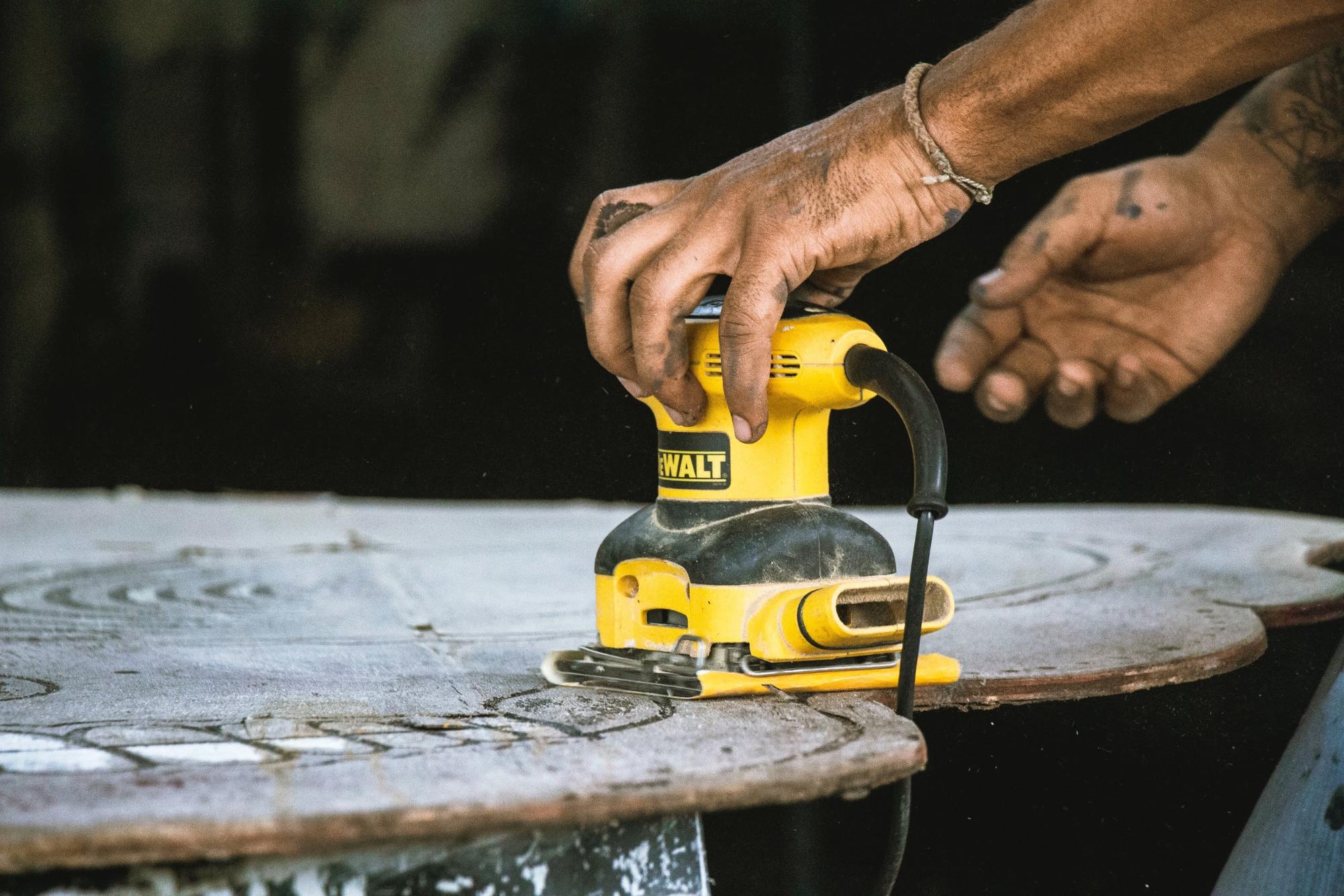
Heat Gun vs Sanding
Using sandpaper to remove old paint is mind-numbingly boring, time-intensive, and seriously hard work. These issues are further exacerbated if you’re tackling numerous layers of years-old paintwork. And — unless you’ve been completing 20 kg bicep curls down at the gym — your efforts will be fruitless.
Admittedly, you can purchase an electric sander to make the job easier. However, while they’re incredible at smoothing wood, they’re disappointing for paint removal. The issue is, as the paint heats up and melts under the friction of the sander, it clogs up the sanding belt — meaning you have to frequently replace it — costing you more hard-earned dollars.
Heat Gun Vs Planer
A planer can be a more rapid way to remove paint than a heat gun. However, the issue is that it doesn’t just strip the gloss — but also the wood. This can result in uneven surfaces where you’ve become a little too enthusiastic with the planer.
Furthermore, they’re useless for molded, ridged, or embossed surfaces — so you can forget about addressing chair legs, baseboards, architraves, etc. Conversely, a heat gun can tackle any surface shape.
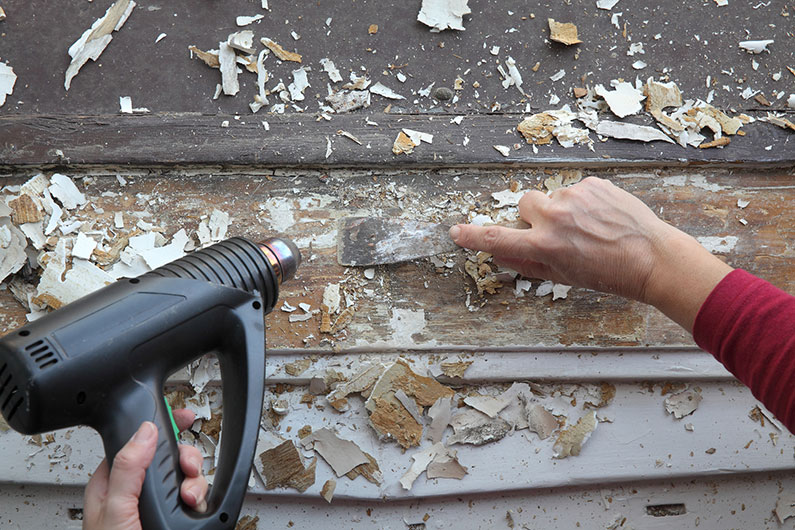
The Best Heat Gun for Paint Stripping
With an absolute multitude of heat guns on the market — it can initially appear a daunting task, trying to select the ideal machine.
To make the process easier, you can check out the ultimate hot air units for paint removal. But, generally speaking, you need a heat gun that:
- Has a minimum temperature of 500 degrees Fahrenheit.
- Is a standard (hairdryer) sized unit.
- Possesses a cord length of at least six feet.
However, some heat guns boast additional characteristics that can increase the flexibility of the unit, such as:
- Additional nozzles — allowing you to redirect the focus of the heat.
- Multiple fan speeds — enabling you to change the heat intensity.
- LCD screen — digital heat guns allow for more precise temperature control
If you will only be intermittently stripping paint, and mainly from plain wood, you won’t need these additional features. However, should you be dealing with multiple base materials and/or tackling intricate work — they can be a welcome aid.
How to Use a Heat Gun to Strip Paint
Chances are, you will be using your hot air machine to remove paint from wood surfaces. Hence, the process I’ve outlined below is angled toward this application.
However, there may be occasions where you’re working with other base materials. That being the case, I’ve also included a short section on tackling paint on plastics, brickwork and metal — where the techniques slightly differ.
Ok, down to business — let’s strip!
What You Need to Remove Paint From Wood With Heat Gun
Before beginning, check you have all the following equipment readily at hand.
Trust me, there’s nothing more annoying than having to keep switching your hot air gun on and off — and then waiting for it to reheat — as you disappear to find an extra tool.
- Heat gun.
- Paint scraper.
- Sandpaper
- Steel wool.
- Sponge.
- Old towel or rag.
- White spirit.
- Warm water.
- Detergent.
- Plastic sheeting or old blanket.
- Respirator mask.
- Goggles or protective glasses.
Listen up.
This is a guide — not instructions that have to be followed to the letter. By all means, adapt my advice to suit your particular circumstances. However, there is one thing I have to stress and is imperative you follow:
Always wear safety equipment.
At the very minimum, this should include protective eyewear and a respirator mask. You seriously don’t want hot flakes of paint flying into your eyes, and the mask prevents inhalation of airborne paint particles and any concomitant gases or smoke.
Which brings me to the first step of using a heat gun to remove paint.
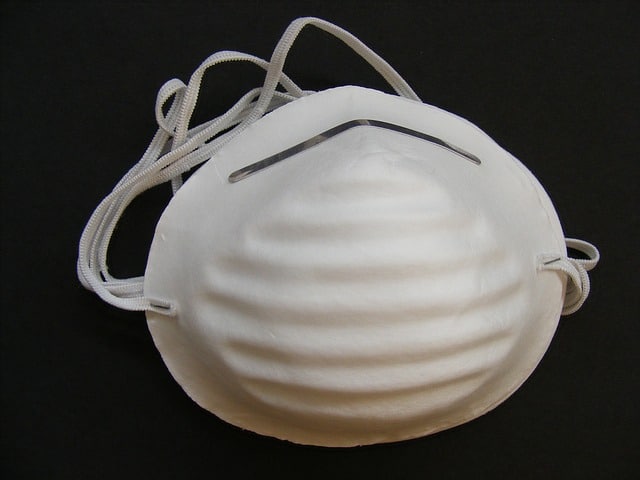
The Lead Test
If your home was built before 1978, your woodwork could be covered in lead-based paint. Similarly, if you have antique furniture, this may also have a coating that contains this metal.
As long as the paint isn’t disturbed, this isn’t an issue. However, when it’s scraped, sanded, or heated, this can create lead dust — which is hazardous.
- If inhaled, this can cause:
- Kidney damage.
- Nervous disorders.
- Damage to a fetus.
- High blood pressure.
- Digestive issues.
- Lack of coordination.
- Joint pain.
- Memory problems.
- Muscle pain.

Rather icky and unpleasant, right? So, if you have any suspicions that you may have lead paint in your house — it’s crucial that you have the material tested before using a heat gun for paint stripping.
There are three methods:
Home Test
You can purchase off-the-shelf lead testers from most DIY stores or you can purchase it from Amazon. Typically, you rub a swab over the paint — which changes color, depending on whether this metal is present or not. The issue is, they can only test the surface layer — not numerous coasts beneath.
Mail Test
This is a more accurate test, as it can detect lead in multiple coats of paint. Usually, you remove a two-inch square of all paint layers with a utility knife (while wearing your mask) and mail it to a laboratory. The EPA (the United States Environmental Protection Agency) has a list of certified testing facilities.
Home Visit
Most US states have certified inspectors who will visit your home and check for the presence of lead. This can be the most cost-effective option if you’re planning on repainting your whole house — as opposed to, say, just one door.
If, through any of the above methods, lead is found to be in the paint, the EPA recommends you employ the services of a professional to remove it.

Preparation for Using a Heat Gun to Remove Paint
I know, the boring bit. All you want to do is crack on and wield your heat gun like a member of Space Force. But, making adequate preparations for stripping paint with a heat gun leads to less mess, increases safety, and ensures a more impressive finish.
- If the item to be stripped is indoors, move it outside wherever possible. If not, the next best location is an expansive workspace, such as a garage with adequate ventilation. This is fairly simple to do if you’re working on a door or table — but, naturally, impossible with fittings such as banister rails or baseboards.Wherever you’re working, but especially if you need to strip indoors, cover the flooring with a plastic sheet or similar. It saves a lot of cleaning up time later — and prevents your partner from moaning about paint flakes in the prized Persian rug.
- Clean the wood with warm water, a sponge, and some general household detergent. I know, this sounds weird. After all, in a few minutes, you’re going to be blasting it with over 500 degrees of heat. But, residual dust and detritus can burn — creating rather unpleasant smoke and possibly causing your wood to scorch.Once cleaned, dry the area with an old towel or clean rag.
- When using heat guns for paint stripping, you can achieve the best results if you have a choice of nozzles. For flat and expansive areas, fit a flared (fishtail) type — and for intricate moldings, a concentrator (conical) end is best. Select the most suitable attachment for your project and fit it to your machine. If your unit wasn’t supplied complete with a variety of nozzles, these can be purchased separately.
- Switch on the heat gun. If your particular machine has a variable temperature control, initially set it to around 500-600 degrees Fahrenheit. Older paint and/or multiple layers may require a higher power level — but don’t go hell for leather to start off with — you can always raise the temperature later.Many higher-end hot air units have a stand, allowing you to put down the machine while it achieves the optimum heat level. However, ensure it’s not pointing toward your partner’s new drapes, sleeping cat, or that box of fireworks you’ve saved for the Fourth of July.
- Put on your safety equipment — at the very least, use a respirator mask and eyewear. For extra protection, don a flameproof boiler suit and heat-resistant gloves.
Using Heat Gun to Remove Paint From Wood — The Method
- Wield the heat gun in your non-dominant hand and the paint scraper in the other hand. Hold the hot air machine approximately three inches away from the paint’s surface and slowly move back and forth, covering an area of around 4-5 inches at time.After a few seconds, the paint should begin to bubble and blister. If it doesn’t, increase the heat setting by around 100 degrees Fahrenheit. If you have a dual temperature unit, change to the highest temperature — but pull the gun back to about six inches away from the material.When using a paint stripper heat gun, always ensure that you keep it moving — otherwise, you may burn the base wood.
- As the paint begins to bubble, begin to remove it with your scraper — moving in the direction of the grain — while still applying heat. A triangular blade is best for detailed areas, whereas a straight edge, such as a putty knife, is more beneficial for flat surfaces. Follow, where possible, the direction of the wood grain.When you strip paint with heat gun, be careful not to gouge into the wood with your scraper. You should apply around the same amount of pressure as if you were buttering a slice of bread. If the paint is being stubborn — reapply the heat.
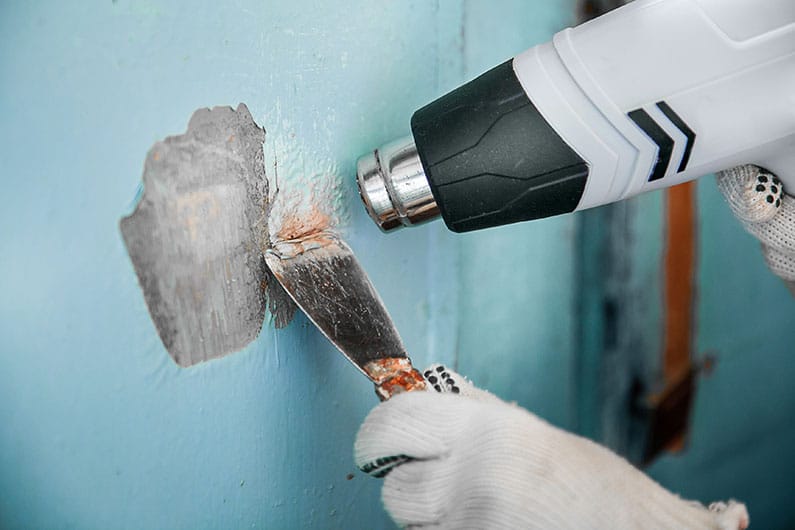
- Once you finished that five-inch area — move onto the next and continue with the above method. Don’t worry if you’re left with a few residual dots of paint — you will address them soon. Otherwise, you run the risk of burning the wood for the sake of a small spot of color.
- After you have removed the majority of paint, turn off your heat gun. Place it in a safe location (on its stand if it has one) while it cools, away from any flammable materials.
- Use the steel wool to take off any remaining spots. Then, gently rub down the bare wood with fine-grade sandpaper, to prepare for repainting or varnishing. As a final step, clean the surface with a rag and white spirit, to create a dust-free base material.
Using a Heat Gun for Stripping Paint on Other Materials
The procedure for removing paint from materials other than wood is generally the same — although are a few considerations to take into account.
Remove Paint From Brick with Heat Gun
There are a multitude of reasons why you may want to take paint off bricks — from accidental spillages, abusive graffiti from your neighbor because you didn’t return his lawnmower, or simply a paintwork trend that has gone out of fashion.
A heat gun will help — but I have to warn you — it’s challenging.
There are three main issues:
- Bricks are porous — so the paint oozes into the material itself, it’s not just sitting on the surface as it does with wood.
- Usually, brick paint is water-based — this means it doesn’t blister, making it tougher to remove.
- Bricks are made from clay and sand — which can crack and flake with excessive heat.
So, you need time, patience, and relatively low heat.
Start with the temperature on your heat gun no greater than 500 degrees Fahrenheit. As the paint will most likely be water-based latex, it will soften, not bubble. Hence, you need to be a little more aggressive with the scraper than you do on woodwork. Try to use a plastic blade with rounded edges — which is less likely to gouge into the brick.
If you’re planning on repainting, thoroughly clean the brickwork after you’ve stripped. This is necessary because you’ll undoubtedly have masses of dust and flakes, that will otherwise ruin your new coat.

Using a Heat Gun to Strip Paint From Plastic
Unless you have a unit with a low-temperature facility, such as the HT4500 Wagner paint stripping heat gun — I would suggest you steer clear of this application.
Many hot air machines are designed to melt plastic — allowing you to both weld and mold this material. It may be a great idea to strip your car’s rear spoiler for some custom paintwork — but not when it turns into a molten mess of sludge when you heat it up.
However, if you do decide to go down this route, set your heat gun to a temperature no greater than 150 degrees Fahrenheit, to prevent damaging the plastic. This may still be insufficient to soften the paint though.
Hence, it may be worth considering sanding, or using a chemical remover instead (although check with the manufacturer that it’s suitable for plastic before you begin).
Stripping Paint With Heat Gun on Metal
Removing paint from metal with a heat gun is relatively simple — it bubbles rapidly, comes off in satisfyingly large pieces, and leaves behind less residue than on wood.
However, precise temperature control is crucial.
Metal warms up faster — and retains heat longer — than wood. This means you don’t require such a hot setting. Start at around 350 degrees Fahrenheit and only increase the temperature if it doesn’t cause the paint to blister.
Too much heat can damage metal — especially softer varieties, such as aluminum. They can tarnish, which will show through your new paintwork. Additionally, ensure you use a heat-proof plastic scraper — not metal — to reduce the risk of scratches.
Top Ten Heat Gun Paint Removal Tips
Here are my top hacks for the ultimate heat gun paint removal:
- Prepare, prepare, prepare!
- Start with a temperature no higher than 500 degrees Fahrenheit (less on plastic).
- Always wear protective safety equipment.
- Work in a well-ventilated area — preferably outdoors.
- Keep the gun moving continually.
- Use a triangular scraper on intricate moldings.
- Heat the paint from a distance of three inches.
- Don’t worry about stubborn flecks — address these later with steel wool.
- When working with wood, scrape in the direction of the grain.
- Perform a lead test on paintwork if it may have been present before 1978.
How to Strip Paint With a Heat Gun Conclusion
Watching paint dry is boring — but stripping paint is possibly the mother-of-all tedium.
However — it’s not if you have a heat gun!
These relatively inexpensive machines save you time, are safer than chemicals, and can actually make your paint stripping projects fun.
So get yourself one of the best paint removal heat guns — possibly the only stripper your wife will approve of!
Thanks for reading and, if you enjoyed learning how to use a heat gun to remove paint — feel free to share this page, so that your buddies may also benefit.
Using Heat Gun to Remove Paint FAQs
Q: Can I Use a Heat Gun to Strip Gloss Paint?
Yes! You can use heat guns to remove paint of all types. It’s most effective on oil-based forms — of which gloss is one example.
Q: Is Removing Paint With a Heat Gun Dangerous?
While you need to take some precautions, there’s no reason that heat gun stripping paint should be hazardous.
Never leave the gun unattended, always wear protective clothing, and ensure that the paint is free from lead.
Q: Can a Heat Gun Strip Paint?
Yes. A heat gun is one of the best ways to remove old paint — being more cost-effective than a chemical stripper, and less labor-intensive than sanding.
Q: Can I Use a Hair Dryer to Strip Paint?
You can try — but it’s unlikely to have any significant effect.
Hairdryers don’t reach a sufficiently high temperature to soften paint. Furthermore, they don’t focus the heat delivery in the same way that a heat gun can. All you will find is that your paintwork becomes pleasantly warm.
Admittedly, it may make inherently soft latex paint slightly easier to remove — but it will not have any impact on gloss.
Q: Will a Heat Gun Remove Acrylic Paint?
Yes. As a water-based paint, acrylic will not bubble or blister like gloss, but it will soften allowing you to remove it with a scraper.
However, always consider your base material. Acrylics are typically applied to paper, card, and plastics — all of which are unsuitable for use with a heat gun as they will burn or melt.










